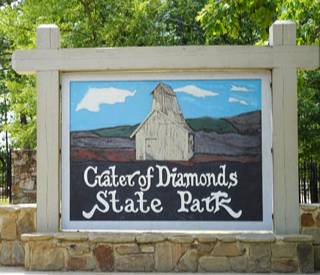Arkansas Diamonds
Contact
University of Arkansas System Division of Agriculture
Cooperative Extension Service
2301 S. University Ave.
Little Rock, AR 72204

Arkansas Diamonds
For more than 50 years employees at the Crater of Diamonds State Park near Murfreesboro, Arkansas, have been plowing the 35-acre patch of ground, ostensibly to expose more gems on the surface. I have been there a couple of times, but so far, I haven’t found any diamonds. But thousands of sharp-eyed individuals have walked and turned the ground before I got there. Maybe all the big ones have been found.
How did diamonds end up in a cow pasture in southwestern Arkansas?
There are two sides to the answer. First the geological answer and then the historical side.
The Geological Story: Volcanic Origins
Last week, I discussed the continental collision that uplifted the Ouachita Mountains at the end of the Pennsylvanian Period more than 250 million years ago. At the time the east-west trending range was coastal with a shallow sea off to the south. The mountains began eroding, resulting in what we now call the Gulf Coastal Plain.
About 105 million years ago and perhaps 30 miles south of the southern part of the Ouachita range, a volcanic tube laden with molten rock forced its way up from a depth of 93 miles to within about 850 feet of the surface. The upper portion of the earth’s crust exploded, forming a cocktail-glass-shaped cavity beneath the shallow sea. Debris from the explosion mostly fell back into the hole and what is called a diatreme (a funnel-shaped volcano that doesn’t produce the classic cinder cone or shield-shaped volcano) formed. This was a one-and-done event in a geological sense, and over the next 100 million years the erosion of the Ouachitas continued, burying the 1,000-acre caldera of the diatreme under hundreds of feet of sediment. Eventually, the sea receded, and about 165 feet of covering sediment eroded, exposing the surface of the old volcano.
How Diamonds Form Deep Beneath the Earth
The crystal growth of carbon only occurs in the presence of tremendous heat and pressure, so diamonds are formed deep in the earth’s mantle. Based on the presence of impurities found in Arkansas diamonds, they are estimated to have been formed about three billion years ago. The carbon sources for crystal growth are various carbonates, which are believed to be rare so deep in the earth. Because of this rarity, the diamonds tend to be relatively small.
When the molten rock is ejected from the depths, it sweeps everything away that is in its path. Most rocks melt, but others partially tolerate the assault. The magma plume is moving fast — some estimate as fast as 150 miles per hour — carrying along a load of mineral debris with it. Arkansas diamonds tend to be rounded in form when found, because this hours-long journey begins to wear on the crystalline structure of the diamond. Estimates are that Arkansas diamonds lose 60 to 80 percent of their mass on the journey to the surface.
Discovery and Early Mining Attempts
The modern-day discovery of the field of diamonds began in 1906 when a farmer named John Huddleston found two unusual crystals in a field on his 243-acre farm. Before long, we were off to the races, trying to develop the first commercial diamond mine in North America. In those first years, they found that from subsurface deposits it was possible to recover about two carats of diamonds from 100 “standard” ore carts. This same sampling was done in both the 1940s and in 1990 with essentially the same results. You have to move a lot of soil to recover a few diamonds.
The Challenge of Commercial Diamond Mining
Initial recovery was pretty good by screening surface soil, but after a few years they switched to hydronic mining — blasting the sticky clay soil with high pressure water. Mining limped along until it ceased in the 1930s. Apparently their screening techniques were not too good because many of the best finds made in the past few decades have been from the out-wash area of the hydronic mining.
From Industrial Interest to Tourist Attraction
 In the 1940s, the U.S. government investigated opening the mine for harvesting industrial
diamonds for the war effort, but again found the recovery rate too low to commercialize.
After that, several tourist mines were operated until 1972, when the State of Arkansas
bought the property. The diamond symbol on our car tags was added in 2012.
In the 1940s, the U.S. government investigated opening the mine for harvesting industrial
diamonds for the war effort, but again found the recovery rate too low to commercialize.
After that, several tourist mines were operated until 1972, when the State of Arkansas
bought the property. The diamond symbol on our car tags was added in 2012.
Famous Finds and Modern Discoveries
Some impressive stones have been recovered from the old caldera. The 40-carat Uncle Sam diamond that is held in the Smithsonian collection was found in 1924 and is the largest ever found in North America. In 2015, the near-flawless white Esperanza diamond (8.5 carats) made the news. Last summer, a 7.5-carat chocolate diamond was discovered.
Keep What You Find
Every year, hundreds of smaller stones make their way from the park. You don’t even have to sneak them out. You find them, you keep them.
